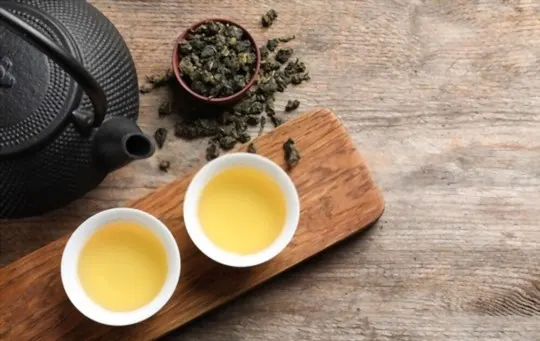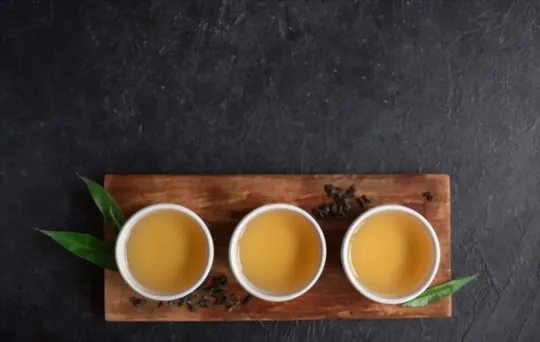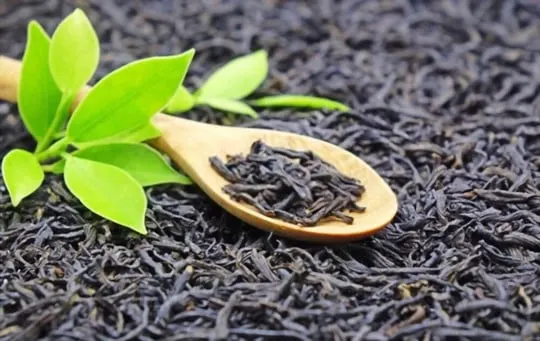Oolong tea straddles the line between green and black tea. It’s a complex character. With a range from floral to smoky, its flavor defies easy description.
We’ve all been there. Sipping cautiously, eyebrows raised, thinking, “What on earth am I drinking?” This is Oolong’s signature move. It dances across your palate leaving a trace of mystery.
Is it bold? Yes. Subtle? That too. One sip might whisper hints of orchids, the next, a robust echo of the earth. Oolong doesn’t play by the rules.
We love it for that. Its unpredictability is a game we’re all too happy to play.
What is Oolong?

Meaning ‘dark dragon tea,’ oolong is a traditional semi-oxidized Chinese tea.
The process involves drying the plant under the sun and also oxidizing it before the following procedure.
There are several types of oolong teas produced in different regions of China.
The flavor and aroma vary from one kind to the other and depend on where they make the teas.
The method of preparing the tea leaves also plays a role in determining a drink’s taste and smell.
Oolong teas contain caffeine, but they also have many nutrients, including antioxidants, vitamins, minerals, and amino acids.
Regular intake can benefit your health in many ways.
It may manage blood sugar levels, improve heart health, boost brain function, promotes bone and tooth health and help with weight loss.
What Does Oolong Tea Taste Like?

With many medicinal teas entering the market, it seems like a difficult task for many to choose the right one.
But when it is about oolong teas, it’s not hard at all.
These have been popular for centuries in China and now around the world.
Oolong teas have the characteristics of both black and green tea.
Oolongs taste closer to black tea but lighter with a hint of roasted or dried fruits, cocoa, or cinnamon.
Some varieties also give an aftertaste of citrus or bergamot.
Some oolongs may also taste a bit like purple tea.
Oolong teas are also known as Wulong teas, qingcha, or dark green teas.
However, some varieties also have specific names, such as Shui Jin Gui (golden water turtle), Da Hong Pao (big red robe), Rougui (cassia), and Bai Jiguan (white cockscomb).
As stated earlier, the flavor, aroma, and appearance of oolong teas differ from one to the other.
So, you will find drinks that are fresh and green with intriguing smells, thick and woody with burnt-like aromas, or fruity and sweet with honey fragrances.
Some may even taste a little bitter, like black tea.
A 100g oolong tea has 1 calorie, 0% fats or carbs, 1mg calcium, and 12mg potassium compared to green tea, which also has the same calories for the same amount.
However, a cup of brewed oolong has 38mg caffeine compared to a cup of green tea which has 29mg of caffeine.
How to Drink and Serve Oolong Tea?

Just like its cousins, black, green, white, or pu’erh, oolong is also a versatile tea, and there are several ways to drink it.
Tea is second only to water in terms of consumption among all the beverages in the world.
However, there are also many people who don’t like tea, and their reason is that it’s too bitter.
But the issue is not with the tea itself but the method of brewing the tea.
There are two aspects that determine how your tea’s flavor comes out.
These are temperature and timing.
Most people make the mistake of making tea with boiling water.
But except for black tea, which produces lovely flavor even with boiling water, oolong and green, pu’erh, and white require your water to be under boiling.
Else, your tea may become too sharp to be called flavorful.
It’s necessary to have the right temperature, neither boiling nor too low, to bring out the tea’s flavor, aroma, and nutrients.
Timing is also an essential factor in making your oolong and other teas aromatic and tasty.
If you steep it shorter than the recommended time, the tea will be tasteless.
Oolong requires 4-5 minutes of steeping time to be perfect, and anything less than that, and you won’t have the desired flavor and aroma.
Apart from drinking, you can also use tea to impart flavor in your cooking.
You can add oolong in desserts and sauces for a savory and nutty flavor.
You can also create rubs and marinades using it.
While oolong is healthy and tasty, you mustn’t overconsume it.
Drinking 4-5 cups daily can be dangerous in the long run.
So, you must drink it moderately to get its benefits.
Conclusion
With oolong containing multiple nutrients, it will be good to add it to your diet.
Brew it as per instructions for a fantastic flavor.
You also know that the taste varies from one to the other, so you have several options.
Instead of the coffee, you can start your day with a cup of oolong tea.
What’s more, you can create your recipes too.
Since there are several varieties, you can choose your favorite type from among them.
It can be sweet, strong, or a little bitter, but each one is a healthy beverage.

What Does Oolong Tea Taste Like?
Ingredients
- Oolong tea
- Ingredients from your favorite recipes
Instructions
- Depending on the ingredients used, the cooking method, and the type of dish, the taste of the food can vary greatly.
- Make sure to select a recipe that will elevate the food’s original flavor, and enjoy experimenting with different recipes!

Andrew Gray is a seasoned food writer and blogger with a wealth of experience in the restaurant and catering industries. With a passion for all things delicious, Andrew has honed his culinary expertise through his work as a personal chef and caterer.
His love for food led him to venture into food writing, where he has contributed to various online publications, sharing his knowledge and insights on the culinary world. As the proud owner of AmericasRestaurant.com, Andrew covers a wide range of topics, including recipes, restaurant reviews, product recommendations, and culinary tips.
Through his website, he aims to inspire and educate fellow food enthusiasts, offering a comprehensive resource for all things food-related.

Leave a comment